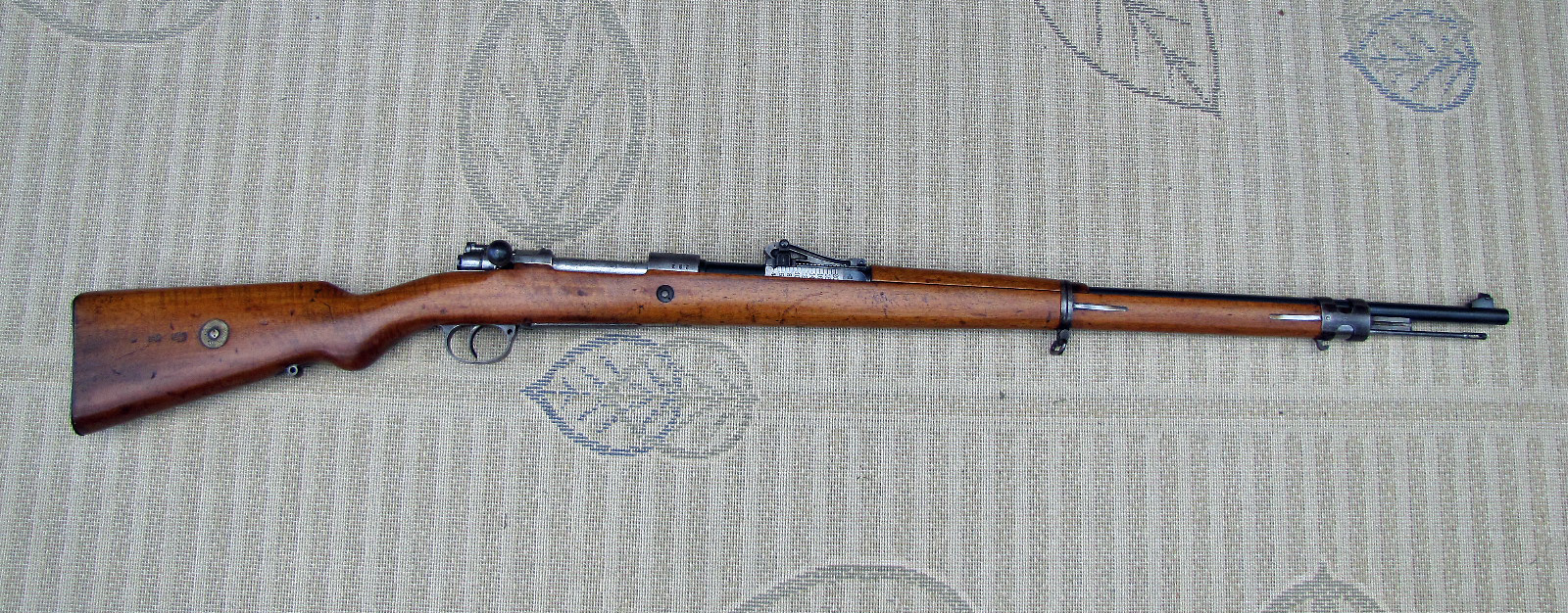
Auction: Location: Marlborough Date / Time: November 01, 2014 10:00AM Description: German Gewehr 98 Bolt Action Rifle and Two Bayonets, c. 1916, serial number 6065m, walnut stock, marked on the receiver ring WAFFENFABRIK/MAUSER A-G/OBERNDORF A/N/1916, with a cleaning rod, reproduction leather sling, a sawback bayonet and scabbard, and a butcher blade bayonet with no scabbard, overall lg.
Estimate $300-500 Some dings and nicks in the stock, action functions properly, saw back bayonet is in good condition, butcher blade has some pitting on the blade. The absence of a condition statement does not imply that the lot is in perfect condition or completely free from wear and tear, imperfections or the effects of aging. Condition requests can be obtained via email (lot inquiry button) or by telephone to the appropriate gallery location (Boston/617.350.5400 or Marlborough/508.970.3000).
Any condition statement given, as a courtesy to a client, is only an opinion and should not be treated as a statement of fact. Shall have no responsibility for any error or omission. Decrypt P25.
Karabiner 98k in mint condition, made in 1940. From the collections of the Type Place of origin Service history In service 1935–present Used by See Wars See Production history Designed 1935 Manufacturer (augmented by several other makers) Produced 1935–45 No. built 14,600,000 + Variants Kriegsmodell, scoped Specifications Weight 3.7–4.1 (8.2–9.0 ) Length 1,110 mm (43.70 in) length 600 mm (23.62 in) 760 m/s (2,493 ft/s) Effective firing range 500 m (550 yd) with iron sights 1,000 m (1,090 yd) with telescopic sight Maximum firing range 4,700 m (5,140 yd) with s.S.

Patrone Feed system 5-round, internal Sights. The Karabiner 98 kurz (; ' 98 short', often abbreviated Kar98k or K98k) is a chambered for the cartridge that was adopted on 21 June 1935 as the standard by the German. Compaq Presario Media Center Sr2050nx Drivers. It was one of the final developments in the long line of military rifles. Although supplemented by semi- and fully automatic rifles during World War II, it remained the primary German service rifle until the end of the war in 1945. Millions were captured by the Soviets at the conclusion of World War II and were widely distributed as military aid. The Karabiner 98k therefore continues to appear in conflicts across the world as they are taken out of storage during times of strife.
Sep 18, 2007 I have a large ring GEW 98 mauser, it is marked on top of the reciever (DEUTSCHE WAFFEN-UND MUNITIONSFABRIKEN BERLIN 1917 ). The serial number. Up for sale today is a German Gewehr 98 serial no. 6718c chambered in caliber 8mm Mauser. This excellent Gewehr 98. Matching barrel and receiver numbers.
Contents • • • • • • • • • • • • • • • • • • • • • • • • • • • • • • • • • • History [ ] In February 1934 the (Army Weapons Agency) ordered the adoption of a new military rifle. The Karabiner 98k was derived from earlier rifles, namely the Mauser Standardmodell of 1924 and the Karabiner 98b, which in turn had both been developed from the. Since the Karabiner 98k rifle was shorter than the earlier Karabiner 98b (the 98b was a in name only, a version of Gewehr 98 long rifle with upgraded sights), it was given the designation Karabiner 98 kurz, meaning 'Carbine 98 Short'. Just like its predecessor, the rifle was noted for its reliability, great accuracy and an effective range of up to 500 metres (550 yd) with iron sights and 1,000 metres (1,090 yd) with an 8×. The desire for adopting new shorter barreled rifles and the introduction of the Karabiner 98k, featuring a 600 mm (23.62 in) long barrel, were reasons for changing the standard German service ball rifle cartridge. The 1903 pattern 7.92×57mm Mauser S Patrone produced excessive muzzle flash when fired from arms that did not have a long barrel like the Gewehr 98. It was found that the s.S.
Patrone, originally designed for long range machine gun use, produced less muzzle flash out of rifles that had a shorter barrel and also provided better accuracy. Because of this the S Patrone was phased out in 1933 and the s.S. Patrone became the standard German service ball cartridge in the 1930s. Design details [ ] Features [ ].